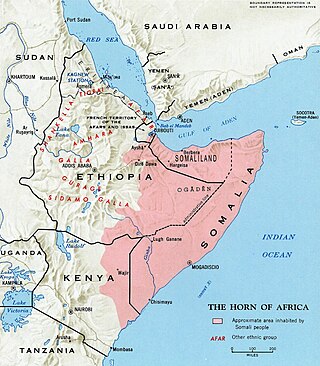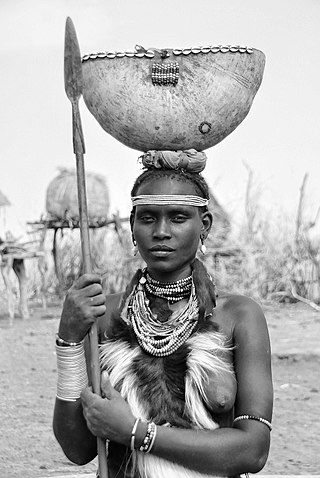Writing system
Jim Ness and Susan Ness of Bible Translation and Literacy and Wycliffe Bible Translators devised a practical spelling and published a 1995 alphabet book. Yergalech Komoi and Gosh Kwanyangʼ published another alphabet book in 1995. An edition of the Gospel of Mark was published in 1997, and other Bible translations were published with this spelling in 1999.
A revision of this spelling is adopted, replacing the digraph ‹dh› by the d with a horizontal stroke through the bowl ‹ꟈ›.
Vowels can be given with the acute accent, ⟨á, é, í, ó, ú⟩, or the circumflex accent ⟨â, ê, î, ô, û⟩.

The Cushitic languages are a branch of the Afroasiatic language family. They are spoken primarily in the Horn of Africa, with minorities speaking Cushitic languages to the north in Egypt and Sudan, and to the south in Kenya and Tanzania. As of 2012, the Cushitic languages with over one million speakers were Oromo, Somali, Beja, Afar, Hadiyya, Kambaata, and Sidama.
Amharic is an Ethiopian Semitic language, which is a subgrouping within the Semitic branch of the Afroasiatic languages. It is spoken as a first language by the Amharas, and also serves as a lingua franca for all other populations residing in major cities and towns in Ethiopia.

Nauruan or Nauru is an Austronesian language, spoken natively in the island country of Nauru. Its relationship to the other Micronesian languages is not well understood.

Somali is an Afroasiatic language belonging to the Cushitic branch. It is spoken as a mother tongue by Somalis in Greater Somalia and the Somali diaspora. Somali is an official language in Somalia and Ethiopia, and a national language in Djibouti as well as in northeastern Kenya. The Somali language is written officially with the Latin alphabet although the Arabic alphabet and several Somali scripts like Osmanya, Kaddare and the Borama script are informally used.
Beja is an Afroasiatic language of the Cushitic branch spoken on the western coast of the Red Sea by the Beja people. Its speakers inhabit parts of Egypt, Sudan and Eritrea. In 2022 there were 2,550,000 Beja speakers in Sudan, and 121,000 Beja speakers in Eritrea according to Ethnologue. As of 2023 there are an estimated 88,000 Beja speakers in Egypt. The total number of speakers in all three countries is 2,759,000.

The languages of Ethiopia include the official languages of Ethiopia, its national and regional languages, and a large number of minority languages, as well as foreign languages.

The Daasanach are an ethnic group inhabiting parts of Ethiopia, Kenya, and South Sudan. Their main homeland is in the Debub Omo Zone of the Southern Nations, Nationalities, and People's Region, adjacent to Lake Turkana. According to the 2007 national census, they number 48,067 people, of whom 1,481 are urban dwellers.
Hadiyya is the language of the Hadiya people of Ethiopia. It is a Highland East Cushitic language of the Afroasiatic family. Most speakers live in the Hadiya Zone of the Southern Nations, Nationalities, and People's Region (SNNPR).
Wolaitta or Wolayttatto Doonaa is a North Omotic language of the Ometo group spoken in the Wolayita Zone and some other parts of the Southern Nations, Nationalities, and People's Region of Ethiopia. It is the native language of the Welayta people. The estimates of the population vary greatly because it is not agreed where the boundaries of the language are.
Melanau is an Austronesian language spoken in the coastal area of the Rajang delta on northwest Borneo, Sarawak, Malaysia and Brunei. There are several dialects—Mukah-Oya, Balingian, Bruit, Dalat, Lawas, Igan, Sarikei, Segahan, Prehan, Segalang, and Siteng.
Alaba-Kʼabeena, also known as Wanbasana, is a Highland East Cushitic language spoken in Ethiopia by the Halaba and Kebena people in the Great Rift Valley southwest of Lake Shala, specifically in Alaba special district, the Kebena district of Gurage Zone, and the Goro district of Oromia Region. The literacy rate of native speakers in their language is below 1%, while their literacy rate in second languages is 8.6%; Alaba-Kʼabeena is taught in primary schools. It has an 81% lexical similarity with Kambaata. However, Fleming (1976) classifies Kʼabeena as a dialect of Kambaata, and Blench (2006) classifies both as dialects of Kambaata. The 2007 census in Ethiopia lists Alaba and Qebena as separate languages.
El Molo is an extinct language belonging to the Cushitic branch of the Afro-Asiatic language family. It was spoken by the El Molo people on the southeastern shore of Lake Turkana, in northern Kenya. Alternate names to El Molo are Dehes, Elmolo, Fura-Pawa, and Ldes. It was thought to be extinct in the middle part of the 20th century, but a few speakers were found in the later 20th century. However, it may now be truly extinct, as the eight speakers found in a survey published in 1994 were over 50. Most of the El Molo population have shifted to the neighboring Samburu language. El Molo also has no known dialects but it is similar to Daasanach.
The (Western) Omo–Tana or Arboroid languages belong to the Afro-Asiatic family and are spoken in Ethiopia and Kenya.
Sheko is an Omotic language of the Afro-Asiatic language family spoken in the area between Tepi and Mizan Teferi in western Ethiopia, in the Sheko district in the Bench Maji Zone. The 2007 census lists 38,911 speakers; the 1998 census listed 23,785 speakers, with 13,611 identified as monolinguals.
Dizin is an Omotic language of the Afro-Asiatic language family spoken by the Dizi people, primarily in the Maji woreda of the Southern Nations, Nationalities and Peoples Region, located in southwestern Ethiopia. The 2007 census listed 33,927 speakers. A population of 17,583 was identified as monolinguals in 1994.
The Omo–Tana languages are a branch of the Cushitic family and are spoken in Ethiopia, Djibouti, Somalia and Kenya. The largest member is Somali. There is some debate as to whether the Omo–Tana languages form a single group, or whether they are individual branches of Lowland East Cushitic. Blench (2006) restricts the name to the Western Omo–Tana languages, and calls the others Macro-Somali.
Maʼa is a Bantu language of Tanzania.
The Mwani language, also known by its native name Kimwani, is a Bantu language spoken on the coast of the Cabo Delgado Province of Mozambique, including the Quirimbas Islands. Although it shares high lexical similarity (60%) with Swahili, it is not intelligible with it. It is spoken by around 167,150 people. Speakers also use Portuguese, Swahili and Makhuwa language. Kiwibo, the dialect of the Island of Ibo is the prestige dialect. Kimwani is also called Mwani and Ibo. According to Anthony P. Grant Kimwani of northern Mozambique appears to be the result of imperfect shift towards Swahili several centuries ago by speakers of Makonde, and Arends et al. suggest it might turn out to be a Makonde–Swahili mixed language.
The Lyélé language (Lele) is spoken in the Sanguié Province of Burkina Faso by approximately 130,000 people known as Lyéla, Léla, Gourounsi or Gurunsi. It is spoken in the towns of Réo, Kyon, Tenado, Dassa, Didyr, Godyr, Kordié, Pouni and Zawara. The language is also sometimes known by the wider term Gurunsi.
Karenni or Red Karen, known in Burmese as Kayah, is a Karen dialect continuum spoken by over half a million Kayah people in Burma.





